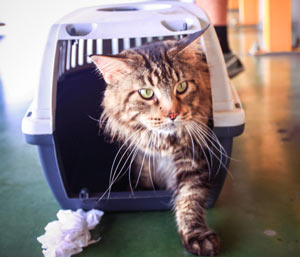How Do I Get My Cat into a Carrier?

Most people with cats have had the experience of trying to get one into a carrier for transport. A cat that is otherwise perfectly agreeable can turn into an angry, hissing mass of claws and teeth in about two seconds flat. However, there are times when you may need to take your cat somewhere, and a carrier is the safest way to do that, with the lowest risk that your feline friend will escape and get lost. Believe it or not, it is possible to train your cat to get into and ride calmly in a cat carrier.
Routine veterinary visits may be avoided if an owner can't get their cat into a carrier. Learn why it's important to take your cat to the veterinarian regularly in "Why Should I Take My Cat to the Vet?"
Choosing a Cat Carrier
The first step in preparing your cat to take peaceful rides is choosing the right carrier. You should get a carrier that is made for the purpose of transporting pets. Using a laundry basket or a box isn't a safe way to move your cat from place to place; she probably won't feel secure, and she could easily get lost or get in your way while you're driving.
Hard and soft carriers are both good options for carrying cats. Soft carriers are lighter and easier to carry. Hard carriers are sturdier and can usually be taken apart, which will help if your cat is reluctant to get out of the carrier once you reach your destination. Sherpa Original Deluxe, and the Catit Design Cabrio
carriers are great ones and are even good for airplane travel.
Be sure to choose a carrier that opens from both the side and the top so you have options for loading and unloading your cat.
You can find more information about how to choose a cat carrier in this informative article: "Choosing A Cat Carrier."
Allow Your Cat to Explore the New Carrier
In order to ensure calm loading and transporting in the carrier, it's important that your cat feels comfortable and secure around and in it. These feelings may take some time to develop. When you first acquire your carrier, here are some things you can do to help your cat explore and begin to feel comfortable with it:
- Leave the carrier, with the door open, in a common living space that you and your cat use together, such as a living room. Alternatively, you may place the carrier in one of your cat's favorite places, such as on a prized resting spot.
- Place a beloved object of your cat's into the carrier. This may be a blanket, toy, or small bed that fits in the space.
- Put a couple of treats or a few of your cat's food kibbles into the carrier.
- Use some Feliway spray inside the carrier. This is a feline pheromone substitute that helps cats feel calm and happy.
- Don't make a big deal about the carrier. Just let your cat explore it at her own pace. When you are playing with wand toys, you can occasionally direct the toy toward the carrier so your cat begins to associate it with positive feelings.
- You may be shocked to find that your cat begins choosing to go into the carrier and sleep. Cats love small spaces, and a comfortable pet carrier definitely fits that bill.
What If Your Cat Still Isn't Exploring the Carrier?
If your cat is not exploring the carrier after you've followed the tips above, place her food and water bowls just outside its entry, and start feeding her there. You may then inch the food bowl back into the carrier over the next week or two. However, be sure you don't do this too quickly and cause your cat to stop eating from stress. Only inch the bowl back into the carrier once she is reliably eating from it at each step, and if she appears upset at any time, move the bowls a bit further away from the carrier for a few days.
Getting Your Cat to Ride in the Carrier
Once your cat has been going into the carrier and resting calmly for several sessions, you may proceed with the following steps:
- While your cat is resting in the carrier, close the door for a few seconds. Open the door quickly, and reward her with praise or a treat.
- Gradually increase the amount of time that the carrier door is closed until your cat rests calmly inside of it for longer periods of time.
- Once your cat will rest comfortably in the carrier for a reasonable period of time, you can start getting her used to being picked up and carried while inside of it. Take your time with this step because it can be frightening for many cats. Once your cat is in the carrier, resting quietly with the door closed, pick the carrier up very gently, just a foot or so off of the ground. When your cat reacts well to this, slowly begin moving the carrier a short distance, stopping, setting it down, and opening it.
- Gradually increase the distance and height at which you carry your cat while she is inside the carrier, slowing down if she appears upset at any time.
You can use a clicker to enhance your training efforts when teaching your cat to enter and ride calmly in a carrier as well as for all other types of cat training. Visit "Clicker Training for Cats: An Overview" for information on how to clicker train your cat.
Special Circumstances for Cats and Carriers
Sometimes you may need to transport your cat somewhere before she has been acclimated to the carrier. If this is the case, you can ease the stress of loading for both you and your cat by using the technique illustrated in "A Helpful Tip for Getting Your Cat into a Carrier."
If your cat vomits or is upset while riding in the car, even though she accepts getting into and being carried in the pet carrier calmly, you can follow the steps in the "desensitization" section of "Car Sickness in Cats" to help her.
Advanced Cat Carrier Training: Learning a Command
If your cat has graduated from regular cat carrier training, you can move on to advanced training and introduce a verbal command for entering the carrier. You can use clicker training to accomplish this or just treats and praise.
- Try training at mealtimes, when your cat is hungry.
- Sit by your cat's open carrier, and get her to come to you. Put a treat in the carrier. When she goes in the carrier to get the treat, say a command such as "Get in." You can do this once or twice a day, and you can even practice it at mealtimes by placing her food bowl in the carrier and giving the command.
You May Also Like These Articles:
How To Take Your Cat To The Vet
Bringing Home a New Cat: A Checklist
Notice: Ask-a-Vet is an affiliated service for those who wish to speak with a veterinary professional about their pet's specific condition. Initially, a bot will ask questions to determine the general nature of your concern. Then, you will be transferred to a human. There is a charge for the service if you choose to connect to a veterinarian. Ask-a-Vet is not manned by the staff or owners of CatHealth.com, and the advice given should not delay or replace a visit to your veterinarian.





